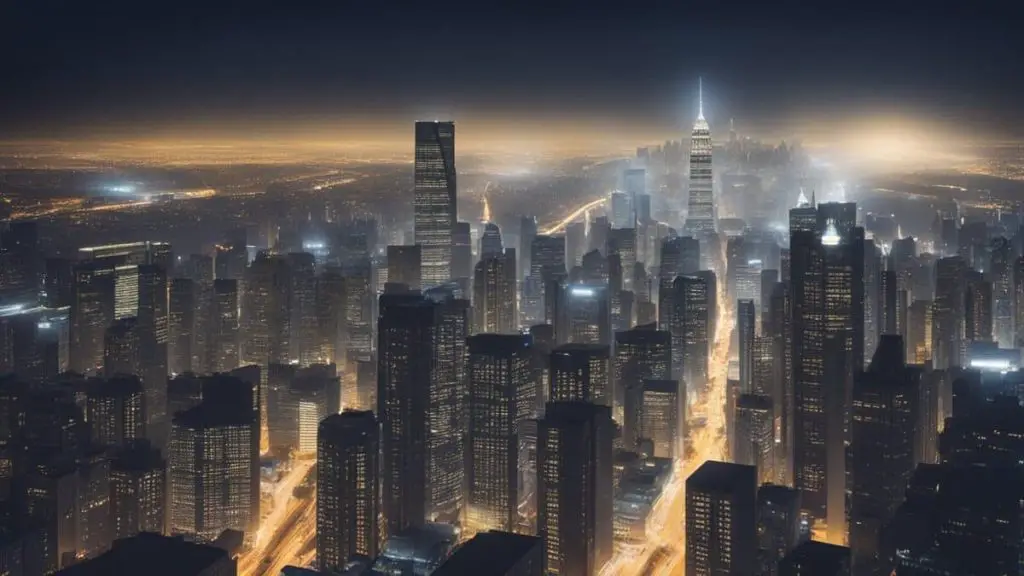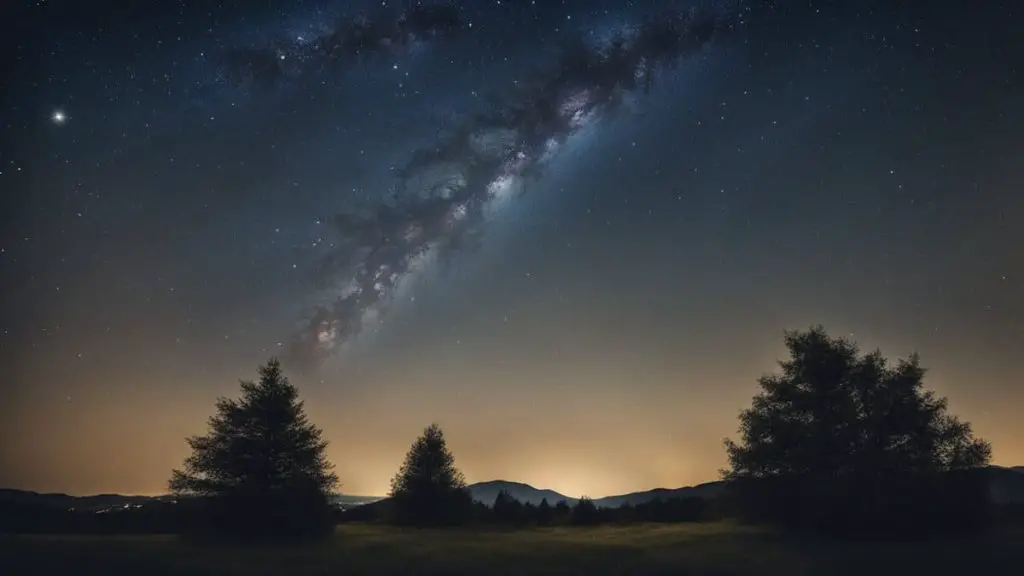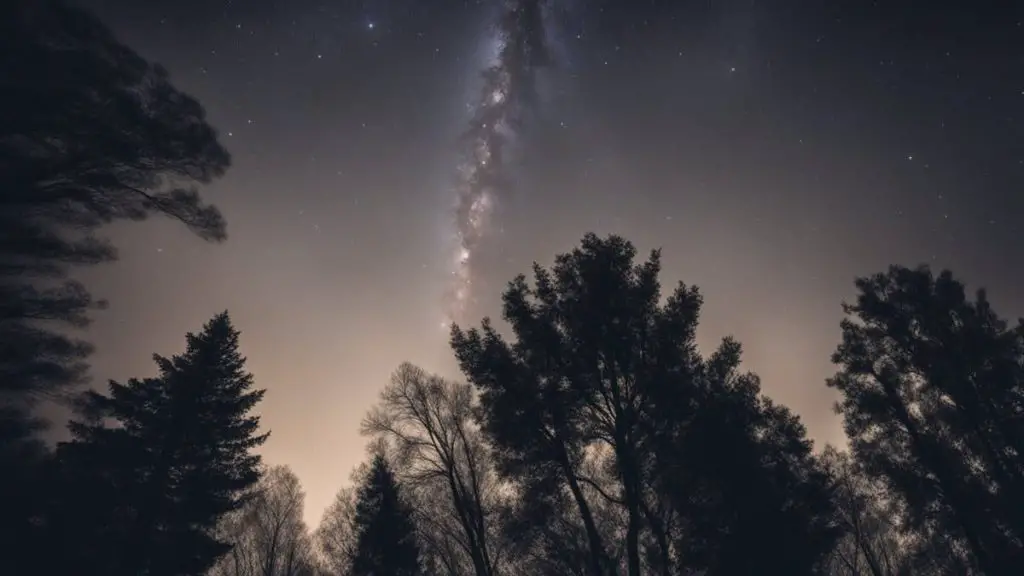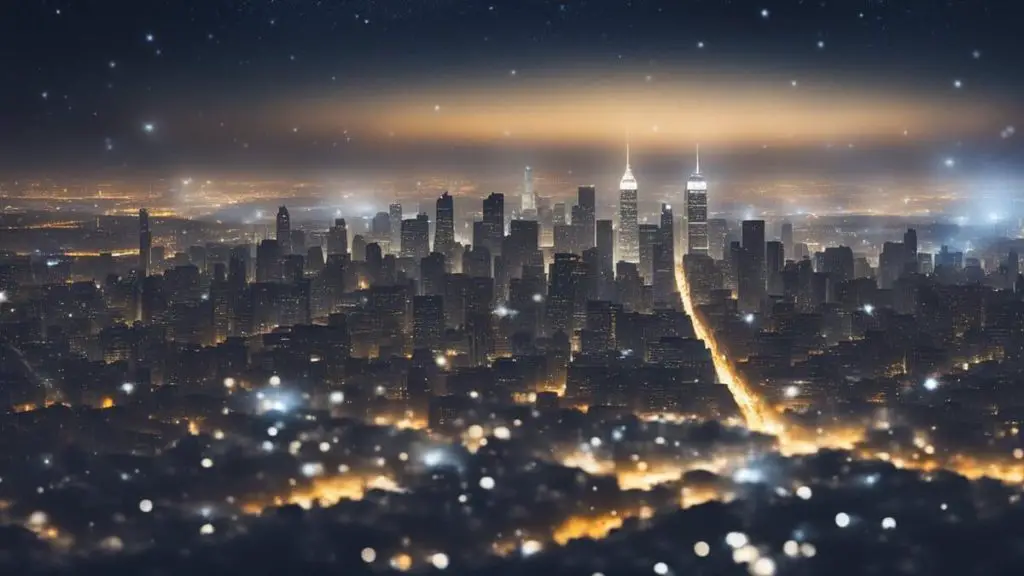You live in a world filled with artificial light. It’s everywhere, brightening your nights, but at a cost.
This excessive light masks the stars above you. It disrupts your sleep, affects your health, and even confuses wildlife. The serene night sky you love is fading away, hidden under a blanket of artificial brightness.
I’ll guide you through understanding how far light pollution reaches and its effects. You’ll learn practical steps to reduce its impact, helping you and the night sky. Together, we’ll reclaim the beauty of a starlit night.
Key Things to Know
- Light pollution affects star visibility, disrupts sleep, and impacts wildlife.
- It can travel up to 70 miles, affecting urban and rural areas.
- Simple actions like using downward-facing lights can reduce its spread.
- Dark skies offer better stargazing and benefit local ecosystems.
Recommended For You
Understanding Light Pollution

Light pollution is too much artificial light at night. It’s a type of pollution that’s more common in urban areas. Light pollution makes it hard to see the stars. From my observations, light pollution considerably dims the natural beauty of the night sky.
There are different types of light pollution:
- Glare – light that is too bright and can cause discomfort.
- Skyglow – the bright halo over cities at night.
- Light trespass – when unwanted light enters your home.
This light pollution affects humans and the environment. For humans, too much light at night can harm our health. It might disrupt your sleep and affect your eyes. It’s not suitable for animals either. It can confuse birds that fly at night. It’s a problem for sea turtles, too.
You can help lower light pollution:
- Turn off lights when you don’t need them.
- Use lights that are not too bright.
- Try lights that point down to the ground.
Awareness of light pollution is growing. During my talks with fellow astronomers, I’ve seen a growing concern about light pollution.
Knowing the consequences is a big step. It’s critical to protecting our night skies. Reducing light pollution can help everyone. It can help you sleep better. It can also let us all enjoy the magic of a clear, starry night.
FREE STARGAZING CHECKLIST
My 5-page Stargazing Checklist will enhance your astronomical observations.
Follow this free checklist to navigate the night sky with confidence, clarity, and a sense of preparedness for a rewarding stargazing experience.

How Far Does Light Pollution Reach?

When you look at the night sky from a city, stars are hard to see. Reflecting on my urban stargazing experiences, the lack of visible stars is strikingly apparent.
That’s because of light pollution. Light pollution is artificial light that spreads into areas where it’s not needed.
As an amateur astronomer, I’ve observed the pervasive spread of light pollution in unexpected areas. It makes it challenging for us to see the beautiful stars.
Understanding the Reach
Near cities:
- Light pollution can be seen from miles away.
- Bright city lights can make it hard to see the stars, even from the outskirts.
In rural areas:
- The sky may be darker, but light pollution can still reach these places. During my trips to rural areas, the intrusion of light pollution is still evident.
- Some light from cities can travel up to 70 miles or more.
Factors That Affect Distance
How far light pollution spreads depends on these factors:
- Brightness of the lights.
- Weather conditions, like fog or clouds.
- The design and direction of light fixtures.
Tips to Reduce Light Pollution:
- Use outdoor lights that shine downward.
- Turn off lights when they are not needed.
- Pick lights that are not too bright.
From my observations, light pollution affects both cities and the countryside alike. Making small changes can help the stars shine brighter for everyone.
The Benefits of Stargazing under Dark Skies

Stargazing under truly dark skies is like opening a door to the universe.
My personal stargazing experiences under dark skies have been nothing short of magical. It lets you see stars, planets, and galaxies far clearer than you can under lighter skies.
Here are some benefits you’ll enjoy:
- Stars Galore: You can see many more stars under a dark sky. You can spot the Milky Way in some places with your own eyes.
- Peaceful Setting: Away from city lights, you’ll find quiet that adds to the peaceful experience of stargazing.
Finding a spot without light pollution can be challenging, but it’s worth it. Pursuing dark skies has been a rewarding journey for me despite the difficulties.
Your local ecosystems also thrive better in the dark. You can even join stargazing groups that meet up in dark spots. This way, you connect with others who share your interest.
Here are steps to find a dark sky:
- Look up dark sky maps online.
- Check for local astronomy clubs.
- Plan a trip to a nearby certified dark sky place.
Remember to give your eyes time to adjust to the dark. This way, you’ll see more stars pop into view. A dark sky journey is not just about seeing stars. It’s also about feeling the vastness and wonder of the cosmos. So, pack a blanket, find a dark spot, and enjoy the night sky.
Finding Good Places to Stargaze: Away From Light Pollution

Stargazing is awesome, but light pollution can ruin the fun. To see the stars clearly, you need to find a dark spot.
Here are easy steps to get away from the city lights and enjoy the night sky:
- Step One: Look for places known for clear skies. Local astronomy clubs often know the best spots.
- Step Two: Use a light pollution map.
- Step Three: Head out on a night when the moon is small. A big, bright moon can outshine the stars.
Tips for a Great Stargazing Night:
- Go to places at least 20 miles from cities.
- Nature reserves or national parks are often fabulous for stargazing.
- NASA’s advice can guide you to ideal locations.
- Bring a sky map to help you find constellations.
- A red flashlight enables you to see without ruining your night vision.
- Snacks and a blanket make the night more fun.
I always remind myself that the darker the place, the more breathtaking the starry view. So grab your gear, find a dark sky, and look up! The universe is waiting for you.
Light Pollution Control and Mitigation

I’ve learned that light pollution is a problem we can all tackle. With the proper rules, designs, and local action, you can help reduce unwanted light in the night sky.
Policy and Regulation
Policies help control light pollution. Communities set up ordinances to manage outdoor lights.
These rules focus on what kind of light fixtures to use and when to have lights on or off.
- The International Dark Sky Association works with folks like John Barentine to create guidelines for better lighting.
- Sustainable development policies aim to reduce carbon dioxide by using energy-saving LED lights.
Sustainable Lighting Designs
The design of lights affects how much light spills into the sky. Sustainable designs fix this.
Here are some ways to make lighting better:
- Light-emitting diodes (LEDs) are innovative because they use less energy and can be made to shine only where needed.
- Outdoor light fixtures should point down. This sends light to the ground, not the sky.
Community Initiatives
You can make a big difference when you and your community work together.
Here’s what you can do:
- Street lighting changes can start with you. Talk to your city about lights that are too bright or unnecessary.
- Share data with local groups on how light affects your area. This can lead to action to reduce light pollution.
By using smart policies, designs, and community teamwork, you can help keep the stars shining bright at night.
Astronomical Research and Sky Visibility

My astrophotography has shown me how light pollution affects our ability to see stars and galaxies. It impacts astronomers as we try to learn more about the night sky.
Effects on Observational Astronomy
- Artificial lights, such as LED bulbs, create a glow that spreads far. This glow makes it hard to see faint stars and other celestial objects.
- The light reflects off dust and moisture in the air, adding to the overall night sky brightness. This is bad news for professional and amateur astronomers as it obscures their view.
- Astronomical research relies on dark skies to study the Milky Way and other galaxies. Light pollution makes this difficult and can ruin the accuracy of observations.
Degradation of Night Sky
- While moonlight naturally brightens the sky, the artificial light from cities can outshine it, affecting your view of the night sky.
- Here’s what’s happening to the sky:
- Skyglow: the brightening of the night sky over inhabited areas.
- A loss of visibility of the Milky Way. In some places, you may not see the Milky Way.
- Groups like the International Dark-Sky Association are working to reduce light pollution. They want to make sure you can still enjoy a star-filled sky.
Remember, every light you turn off helps keep our skies dark and full of stars!
Technological and Lighting Solutions

In this section, you’ll learn how new lights and intelligent systems help fight light pollution.
Advancements in LED Technology
LEDs, or light-emitting diodes, have changed lighting for the better. They use less energy than old bulbs and last longer.
Here’s what’s good about the new LEDs:
- They’re more energy-efficient, saving electricity and your money.
- Blue light from LEDs can be reduced, which cuts light pollution.
Smart changes in LEDs mean clearer skies and lower costs.
Smart Lighting Systems
Smart lighting systems are clever. They adjust based on what’s needed. Look at these benefits:
- They turn off or dim when no one’s around, cutting waste.
- Smart tech matches lighting to the time and place to prevent too much artificial light.
By using smart lighting systems, you can help keep the night sky dark and save energy at home.
Effects on Human Health and Society

Light pollution reaches far beyond just hiding the stars from our view. It can mess with your sleep and even your health.
Impact on Sleep and Health
Your body has a natural clock called the circadian rhythm. This helps you feel awake in the day and sleepy at night. But too much artificial light can throw off this clock.
Here’s what you might face:
- Trouble falling asleep because your body is confused about when it’s nighttime.
- Lower levels of melatonin, a hormone that helps you sleep and fights off sickness.
- Increased risk of problems like cancer, from breast to prostate cancer.
Societal and Economic Consequences
Regarding society, light pollution touches more than just the night sky. It can make life more challenging in the following ways:
- Work: If you’re tired from not sleeping well, work can be more complicated and less safe.
- Public Health: Hospitals may see more people with sleep issues, adding stress to our healthcare system.
- Society: It costs money to light up the night. Less light pollution means saving cash and energy.
Remember, you have the power to help reduce light pollution and its impacts on health and society. Keep your outdoor lights off when they’re not needed. Choose lighting that’s less bright and points down. These small actions can make a big difference.
Influence on Wildlife and Ecosystems

Light pollution travels far and wide, affecting various forms of life. It not only alters natural behaviors but can also have harmful effects.
Terrestrial Wildlife
Animals on land, such as birds and bats, rely on darkness. Light pollution interferes with their natural rhythms:
- Birds: Migratory birds become disoriented by bright, artificial lights, leading to fatal collisions with buildings.
- Bats: These night-time hunters avoid lit areas, making it harder for them to find food.
Aquatic Life
Marine creatures also feel the impact of excessive artificial lighting:
- Sea Turtles: Hatchlings use moonlight to find the sea. Bright lights from nearby beaches can send them in the wrong direction.
- Fish: Light pollution affects fish behavior and breeding patterns, changing how they interact in their environment.
Plant Life
Plants need normal light and dark cycles, too. Here’s what happens with too much artificial light:
- Nights become too short for plants to complete their night-time activities.
- This confusion can lead to less successful growth and reproduction.
By understanding the influence of light pollution, you can make choices to help reduce its spread and protect our planet’s diverse ecosystems.
Frequently Asked Questions
How can light pollution affect long-term health?
Light pollution’s long-term impact on health includes disrupted sleep patterns and potential hormonal imbalances. Continuous exposure to artificial light at night can lead to chronic sleep disorders and may affect overall well-being.
Is light pollution a significant factor in global energy consumption?
Yes, light pollution contributes significantly to global energy consumption. Excessive and inefficient use of outdoor lighting leads to increased energy demand, contributing to higher carbon emissions and energy costs.
Can wildlife adapt to light pollution over time?
Wildlife generally struggles to adapt to light pollution. Many species have fixed biological patterns tied to natural light cycles, and sudden changes due to artificial light can cause lasting ecological disruptions and affect biodiversity.
TL;DR
- Light pollution, caused by excessive artificial light, diminishes star visibility, disrupts human sleep, and negatively impacts wildlife.
- It can extend up to 70 miles from its source, affecting urban and rural areas.
- Simple measures like downward-facing and less bright lights can significantly reduce light pollution.
- Dark skies are crucial for optimal stargazing experiences and for preserving local ecosystems.
- Community efforts and sustainable lighting practices are vital to mitigating the effects of light pollution.
Your thoughts and questions matter to me, and I’m here to share insights from my stargazing journey.
Whether you’re curious about light pollution, seeking stargazing tips, or want to share your night sky experiences, I’d love to hear from you. Please leave your questions and comments below.
Let’s explore the universe of astronomy together!




